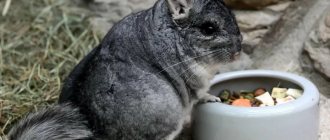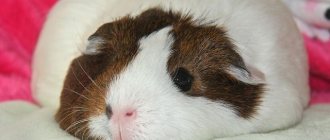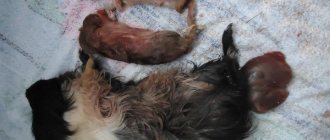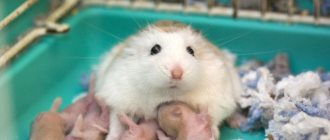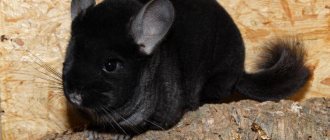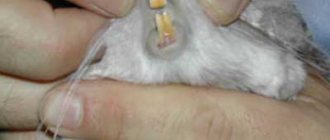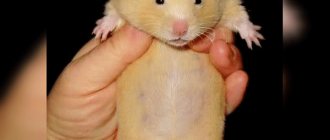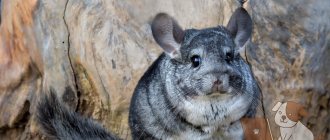Information / Childbirth in chinchillas
So, you have discovered a pregnancy in a chinchilla, approximately determined the timing of birth and the expected number of newborns, put the female in the maternity cage and observe... Immediately before giving birth, the female goes down and makes characteristic movements - she sits down in a corner, stretches, licks a loop. Preparing for childbirth for first-time mothers takes longer. Experienced females give birth quickly, sometimes without even going down, on the top shelf.
Puberty and mating
Most chinchillas experience their first heat at 4-5 months. By this time, the female reproductive system is ready for fertilization. But an incompletely formed organism will not cope with bearing puppies and giving birth. Therefore, early fertilization can lead to the following adverse consequences:
- exhaustion of the female’s body;
- miscarriage;
- birth of stillborn cubs.
Veterinarians recommend that chinchillas begin mating at the age of 8-9 months for females and 6-7 months for males. And in order to minimize complications during childbirth, it is better to postpone the birth of the couple until they are one year old.
It is necessary to carefully prepare for the process of mating animals. First, you will need to introduce potential partners by placing them in 2 cages, standing at a distance of 15-20 cm from each other. When the fluffies get used to the sight and smell of each other, you can briefly place the female with the male.
In the absence of aggression, it is allowed to leave animals together for 3-4 hours a day. By the time of estrus, the couple should become friends. The female's loop will indicate readiness for mating - it will become wet, open slightly and acquire a rich pink hue. At the same time, the behavior of the male will change - he will show signs of attention, make inviting sounds and, most importantly, make attempts to cover the girl. Typically, sexual intercourse in chinchillas occurs at night and lasts only a few seconds.
The fact that everything went well will be signaled by the male’s fur and dried seminal fluid scattered around the cage. To be sure, you can leave the couple together for another 2-3 days.
Prenatal period in a chinchilla
On average, chinchilla pregnancy lasts about 120 days. The exact period depends on the breed, age and physiological characteristics of the female’s body. Most often there are up to four cubs in a litter.
A chinchilla can give birth to up to three litters per year, provided that estrus occurs at a normal interval - once every month and a half.
Some females are ready to breed twice a year or even once. However, many breeders advise not to have more than two litters from a female, since frequent births exhaust the body.
To ensure that the birth is successful and does not cause complications, fluoroscopy or ultrasound examinations should be performed late in pregnancy. By this time, the cubs have already formed and taken their position in the uterus. You can determine not only their size and quantity, but also the correct location. Based on the data received, each breeder can understand whether the help of a veterinarian will be needed or whether the female will cope on her own.
Preparing for childbirth consists of following the following rules:
- If the female lives with a male, two weeks before giving birth she is transferred to a separate cage,
- If the female is kept alone, a week before giving birth, the bottom of the cage is covered with a thick layer of clean and fresh hay,
- It is necessary to remove all unnecessary shelves in the cage, remove labyrinths and ladders,
- The temperature in the room with the cage should not fall below +20 and rise above +24 degrees,
- Two weeks before giving birth, they gradually begin to exclude concentrated feeds from the diet,
- With the exception of concentrates, the portion of hay and succulent feed is increased.
How to understand that a female is pregnant
In the initial stages, it is very difficult to determine that a chinchilla is pregnant. The first signal about the interesting position of the female can be the so-called vaginal plugs scattered around the cage - the sperm of the male that has dried in the form of flagella. However, this is only an indirect sign indicating the mating of animals. One hundred percent pregnancy can be judged by the following changes in the female’s body:
- Swelling of the nipples . In ordinary life, chinchillas have small pale pink papillae, which are very difficult to find in the animal’s fur coat. In a pregnant pet, the nipples increase in size, turn red, and can be easily found on the abdomen.
- Decreased physical activity . Pregnant chinchillas almost completely refuse active play and prefer to spend most of their free time lying on their side.
- Increased frequency of the urge to urinate . A pregnant female goes to the toilet twice as often in a small way due to the fact that the actively growing uterus puts pressure on the bladder.
- Increased appetite . For normal bearing of offspring, the female needs more energy. Accordingly, she switches to a more saturated diet.
- Absence of appropriate signs during the next estrus . Namely, increasing and moistening the loop.
- Abdominal enlargement . This sign is visible by 7-8 weeks of pregnancy. It is especially noticeable when the animal is in an upright position.
- The surest way is to carry out ultrasound diagnostics or x-rays . These procedures are carried out to ensure that chinchillas are developing correctly.
Also, a few days before the puppies are born, the female’s loop swells and turns red. The male may mistake such changes for the beginning of estrus and cover up the expectant mother. Therefore, 10-12 days before the planned date of birth, it is better to place the boy in a separate cage.
Once pregnancy is established, the female will need to be weighed once a week. Normally, the increase should be 15-20 g. If there are significant deviations from this indicator, as well as in the presence of any suspicious symptoms, the chinchilla will need to be shown to a veterinarian.
How does childbirth go?
As a rule, childbirth occurs in the morning. Their course normally lasts up to 2.5 hours. The onset of childbirth is preceded by characteristic changes in the behavior of the female.
Signs of approaching labor
You can find out that a female is about to give birth not only by counting the days on the calendar, but also by her actions. Thus, one of the main factors in the approaching birth is the construction of a nest - increasingly, a chinchilla can be found chewing the straw bedding to make it softer. She takes the softened straws to one corner. It also stores its plucked wool there. Construction of the nest lasts about 2–4 days.
You will probably be interested to know how many years chinchillas live in wild and domestic conditions.
After the nest is built, the female falls into a state of rest - she lies a lot, sleeps, practically does not eat, and often rests on her side or back.
Before giving birth, her body weight decreases by 15–25 g, and her rectal temperature decreases by 1–1.2 degrees. There is a drooping of the abdomen, drooping of the sides, and swelling of the genitals.
How to prepare
Closer to birth, the owner should prepare moisture-absorbing diapers, hydrogen peroxide, disposable syringes, saline solution, milk replacer, and also put the veterinarian’s phone number in a visible place. All these items will be necessary if something goes wrong during childbirth and the mother and her babies need help.
What to do, how to help
Like most animals, when a chinchilla gives birth, it does not require outside help. Usually childbirth proceeds quickly and without problems. The intervals between the appearance of babies range from several minutes to 1–2 hours.
Find out more about the types and colors of chinchillas.
After all the babies come out of the womb, the placenta appears. The chinchilla eats it. However, problematic births also happen. This happens when the fetus is too large or is not positioned correctly in the womb.
Problems also arise if:
- the female was ill during pregnancy;
- the woman in labor is too young;
- The chinchilla was injured while she was pregnant.
Childbirth can be classified as pathological if the following situations occur during it:
- the interval between the appearance of cubs is 4–6 hours or more;
- the baby is not born within 20–30 minutes, but some part of his body appears from the vagina;
- profuse uterine bleeding began;
- no contractions;
- the female is in an emaciated state.
In order to pay attention to the pathology in time and provide assistance to the woman in labor, you should carefully monitor the birth process and record the time of birth of the babies and the intervals between their appearance.
Important! All of the above situations require an immediate call to the veterinarian.
If for some reason it is not possible to get veterinary help, then the owner of the chinchilla can help her only if the baby is stuck in the vagina - for this, the part that has already appeared must be carefully lubricated with Vaseline and pulled lightly during contractions.
In other situations, an inexperienced person will not be able to help. In case of problematic childbirth, it is still necessary to take the woman in labor to a veterinary center, where she will receive qualified assistance and, if necessary, a caesarean section will be performed.
Caring for a pregnant woman
In order for pregnancy and childbirth to proceed without complications, the expectant mother will need to create comfortable living conditions. To do this, just follow the following recommendations:
- Ensure complete peace in the room with the cage. The female should not be disturbed by loud noises or unexpected guests. You also need to make sure that the cage is not exposed to direct sunlight and that the room is not hot.
- Remove the running wheel, shelves, ladders, and hanging hammocks from the cage - this will protect your pet from falls. It is also better to remove the tunnels, since the female can get stuck in them.
- Clean the cage daily. In unsanitary conditions, the animal can get sick, as a result of which future babies will suffer.
- Introduce more high-calorie foods into the expectant mother's diet - cereals, fruits, vegetables, dried fruits. And also protein dishes (kefir, yogurt, crumbly cottage cheese).
- Provide your pet with warm bedding in the form of hay or wood filler.
Additionally, you will need to limit tactile contact with the pregnant chinchilla. If there is no need, you should not pick her up or let her out of the cage for a walk.
Particular attention will have to be paid to the health of the female. Ideally, during pregnancy she should undergo 2-3 routine examinations at the veterinary clinic. This includes an x-ray, which will help determine the number of babies and their presentation, as well as identify possible problems.
A pregnant chinchilla should never be lifted by its tail. This will become a real stress for her and can provoke premature birth.
Nutrition after childbirth
A properly selected diet is the basis for the female’s recovery after childbirth.
The menu should include the following product groups:
- Roughage. It is useful for improving digestion and teeth. They give the rodent tree shoots, twigs and grass.
- Cereals. These include grains, cereals, seeds, bran. Cereals are given in their natural form or porridges are made from them.
- Ready-made mixtures. They contain granules of crushed millet, oats, barley, bone meal, vitamins and minerals. Chinchillas after giving birth love food for guinea pigs and rabbits.
- Fruits (pears, apples, bananas) and vegetables (tomatoes, carrots, cucumbers), berries (currants, grapes, watermelon) and herbs (burdock, nettles, parsley, sorrel). The fruits are cut into small pieces and served raw or boiled.
If complications have occurred, it is better to show the animal to a veterinarian, who, after examination, will give qualified recommendations.
How long does pregnancy last
Depending on the individual characteristics of the female’s body and the number of puppies being carried, a chinchilla’s pregnancy can last from 105 to 120 days. In young females, gestation is longer. This is due to the fact that the fewer babies a chinchilla has, the longer it bears them. And in the first litter, as a rule, there are no more than 2 puppies. Then the chinchilla mother is pregnant for 115-120 days.
Older females can give birth to 5-6 babies at once. And their gestation period is only 100-105 days. It is worth noting that during multiple pregnancies, newborns are born with closed eyes and a small amount of fur. While chinchillas from a small litter, as a rule, are immediately sighted, stronger and covered with thick fur coats.
Hunting females
The hunting period of a female chinchilla has its own cycle, which consists of 40-41 days. On average, it lasts from 2 to 5 days.
It is not difficult to identify the moment when the hunt begins; just observe its behavior: the chinchilla begins to behave more actively, does not touch the food, and there is a complete mess in the cage (she throws everything out of it). In addition, there are a number of external signs that will help ensure the onset of sexual desire: swelling and slight hyperemia of the external genital organs.
Preparing for childbirth
The approach of childbirth in a chinchilla can be judged by several signs. The most important thing is that the female shows unreasonable anxiety and becomes restless. If the male is not resettled by this point, the expectant mother will begin to attack him.
Also, by the time labor begins, the chinchilla will begin to build a nest. To do this, she will drag straw to the chosen place and pull out her own wool, which will act as “insulation.” At the time of building the nest, the pregnant female becomes very tired, so she will sleep more often and lie on her back.
Shortly before the planned date of birth, you will need to perform several mandatory actions:
- remove the male;
- cover the cage with the female with a breathable cloth;
- fill the drinking bowl with fresh water;
- If there are recommendations from a veterinarian, prepare the necessary medications in advance.
If the chinchilla did not take care of arranging the nest before giving birth, you will have to help her. To do this, it is enough to buy a warm house or insulate your pet’s favorite place with chopped straw.
If the pregnancy was difficult, you can arrange in advance for the presence of a veterinarian at the birth to be on the safe side.
What to feed a pregnant chinchilla
Females that bear cubs need high-quality and fresh food.
Products you need to add to the menu:
- chopped plants (alfalfa, calendula and strawberries) plus beebread for good lactation;
- barley or oat sprouts, due to the presence of vitamin E (its deficiency causes fetal malformations or miscarriages);
- pieces of apples 15-20 days before birth;
- special food from a veterinarian store with a high protein content, for better lactation and easy pregnancy.
The diet will be supplemented with greens, a mixture of powdered milk and cereal, and rose hips. Additionally, calcium gluconate is prescribed to support the skeleton.
Thyme and mint have a negative effect on lactation; it is better to exclude them. You will also have to reduce roughage (corn cobs, straw and hay) by about a quarter, increasing the amount of juicy fruits, vegetables and protein (cottage cheese, yogurt, meat and bone meal, etc.).
Birth of puppies
Immediately on the day of delivery, the chinchilla becomes very restless. She flinches at every rustle, refuses to eat and sits in the prepared nest. When childbirth occurs, the female stands on her hind legs, resting her front legs on the bars of the cage. In this position it is easier for her to push the babies out.
As the puppies emerge, the female licks them and eats the afterbirth. Since the cubs can quickly freeze and get sick with wet coats, they immediately hide under their mother’s warm tummy. If a dead puppy is found, it will need to be removed immediately. Otherwise, the woman in labor may experience stress and refuse to feed the rest of the babies.
A few hours before giving birth, a chinchilla may experience so-called false contractions. During this process, she stands on her hind legs, her ribs are strongly retracted, and her stomach contracts.
As a rule, healthy females cope with the birth process on their own. After which they quickly recover. However, you should not place a male with a young mother for another 5-6 months - this period of time is necessary to fully restore strength and prepare the body for a new pregnancy.
Postpartum period
Females who have given birth for the first time often experience postpartum stress. For them, what is happening is not entirely clear. This can be noticed by restless behavior, aggression and rejection of children. Usually the maternal instinct is still stronger and the female accepts the cubs after some time.
Therefore, do not panic if immediately after giving birth the chinchilla refuses to feed the babies.
Just a day after the chinchilla gave birth, she is already ready for another mating. However, this will lead to a lot of stress. Therefore, if the female gave birth in the same cage with the male, he must be placed in another cage for two to three days. After three days, the male can be returned home - he will help the female take care of the cubs.
The diet of a nursing chinchilla is not much different from the diet before and during pregnancy. It is recommended to feed the female with the most pure and vitamin-rich food possible. It’s good to add cottage cheese, milk (powdered) and fresh eggs to your diet. It is recommended to make an additional feeder for nettles, leaves and fruits of rose hips, hawthorn and strawberry leaves, which is placed next to the nest. An additional drinking bowl is also hung next to the nest.
The chinchilla has three pairs of nipples, but not all of them are active. Most often, the first and second pair are dairy. If babies suck nipples, then even in inactive ones milk appears over time. The breeder needs to monitor the feeding of the pups, since sometimes not all puppies have enough milk. Strong cubs often push away weak ones, which leads not only to slower growth and development, but also to death. If some puppies are stunted, they need to be artificially fed.
For feeding, use a mixture of one part unsweetened condensed milk and two parts chamomile infusion.
The mixture is heated in a water bath to room temperature and the babies are given small portions from a syringe without a needle several times a day.
Possible problems and complications
In most cases, childbirth in chinchillas occurs without complications, and young mothers themselves cope well with the birth of their babies. The average duration of the labor process is 2-3 hours. If the birth lasts up to 5 hours, the female needs help. Perhaps one of the puppies is stuck in the birth canal. To provide assistance you will need:
- give the woman in labor a few drops of sweet water or syrup - this will help restore the chinchilla’s strength and give it vigor;
- Gently massage the tummy - in this case you need to use soft, stroking movements and under no circumstances press;
- If one of the puppies is halfway out and does not move further, you need to lubricate its body with Vaseline and try to carefully remove it in time with the contractions, twisting it slightly clockwise.
If labor has completely stopped, or if bleeding occurs, it is necessary to urgently take the chinchilla to the veterinarian. If possible, it is better to call a specialist at home. In such a situation, a caesarean section will have to be performed to save the lives of the mother and babies.
Birth injuries and weakened puppies
If 2–3 puppies are born, perhaps some of them are weak. For example, a puppy is born in the membranes. The baby cannot get rid of the shell on his own, and the mother chinchilla is busy giving birth to the next chinchilla and is not distracted to help him. Help the puppy yourself - grab the membrane with your nails and remove it from the baby’s face and body. Use a cotton swab to clear amniotic fluid from your mouth. Then perform artificial respiration: in the “standing on your paws” position, bend and straighten the baby’s body several times to open the lungs. Open your eyelids and wipe your eyes with a cotton swab. Warm and dry the newborn in your palms or in a towel. Do this work for the chinchilla mother, who is currently busy giving birth to her next baby.
During prolonged labor, when the fetus comes out with difficulty, the chinchilla helps itself and pulls out the fetus, grabbing it with its teeth. If the fetus moves head first, the female pulls it by the neck. If the fetus comes out in the wrong position with its legs forward, the woman in labor pulls it out by grabbing the legs or tail. A chinchilla gets damaged from the female's teeth. Lubricate wounds on a newborn with a healing ointment, such as Levomikol. Sometimes birth injuries lead to death or disability in newborns.
How many babies does a chinchilla give birth to?
Depending on the age of the expectant mother, she can bring a different number of puppies. Older females can give birth to more cubs than younger females. So, an older individual gives birth to about 5-6 puppies, but a young one can give birth to 1 to 3 chinchillas.
Important. It is necessary to understand that if there were more than three puppies in the litter, the rest will need to be supplemented, because the mother most likely will not have enough milk for all of them. For feeding, use a glass pipette or syringe. Cow's and goat's milk is used as a top dressing, as well as, perhaps, diluted condensed milk.
An important question about offspring
It is worth thinking about why an animal in captivity produces fewer offspring than when living in the wild. Most likely, this is influenced by the following factors:
- When living at home, rodents spend most of their time in confined spaces. It is simply impossible to reproduce normally in cramped conditions.
- Often the animal receives an insufficiently balanced diet. Excessive consumption of proteins or fats leads to a decrease in the number of offspring and also affects the survival rate of puppies in the first month of their life.
Reference. In a year, a female can bring cubs up to three times.
Interesting things about offspring
- The animal reaches sexual maturity at 6–7 months.
- The duration of pregnancy is 106–114 days.
- The lactation period lasts on average 40–60 days.
- The female has three pairs of working nipples, this is enough to freely feed three babies.
- On days 5–7 of life, small chinchillas begin to eat food.
- A healthy chinchilla gives birth to puppies on its own without human assistance.
Reference. If you are planning further breeding of these rodents, you need to leave the strongest and most fertile individuals with good hair for the tribe.
Source
What to do if your chinchilla gives birth to puppies
If your furry pet has finally given birth to a wonderful baby or one baby, you need to take care of restoring your pet's postpartum health in order to create optimal, comfortable conditions for new family members to thrive:
- Some owners do not separate adult chinchillas after birth; this may result in another mating within 24 hours of birth. Gentle females may become aggressive towards males after birth and may chase males around the cage, causing injury to the delicate limbs of newborn pups;
- The cage with newborn puppies should have a minimum size between the bars, and all shelves where a tired chinchilla can hide from babies should be removed;
- The dog in the newborn crate should hang as low as possible so that the babies can easily reach it, fresh, dry hay with stems should be placed in the enclosure or cage daily, newborn puppies begin to eat hay from the 2nd or 3rd day of life;
- Chinchillas can bathe in the sand 10-14 days after giving birth, for this they are placed in a cage for a nursing female with babies.
Recommendations for setting up a cage for cubs
Active puppies can often get injured, so dangerous situations need to be avoided. You will have to move the chinchilla and its offspring into a hamster cage, where the distance between the bars does not exceed 1 cm, or line the mother’s home with a mesh with small cells. All accessories from the cage must be removed, it is important to exclude any opportunities for the cubs to get out.
Feeders and drinkers should be placed at low heights so that babies have access to food and water. It is important to teach them to feed themselves from an early age. If there was a place for artificial nutrition, then you need to install an additional milk bowl.
Every day you need to clean the cage: change the bedding, clean and update the feeders and drinkers. To prevent intestinal diseases, it is recommended to wipe the floor of the enclosure with salicylic alcohol.
Newborn nutrition
If the number of babies in the nest is small and lactation is proceeding well, then the newborns receive the necessary nutrients from their mother’s milk. When small animals show depression, inactivity, sit and squeak, then it is necessary to introduce complementary foods into the diet of growing chinchillas. It is best to use baby formula from popular brands. It is prohibited to use cow's milk (especially condensed milk), as these products can cause liver and kidney diseases.
How to properly feed small chinchillas?
First you need to take the newborn, wrap it in soft cloth and secure it in one hand, while the other will hold the pipette to carry out feeding. The first portion should not exceed 1 ml, but gradually the amount of the mixture should be increased. In the first days of life, the baby needs to be fed every 2 hours. You must remember to pay attention to the chinchilla, regularly massaging its breasts and squeezing droplets of milk. This is not only an excellent prevention of mastitis, but also an opportunity to improve lactation.
7 days after birth, babies begin to become interested in their mother's food. You can add food intended for animals up to 12 months to the animals’ diet. While animals are growing, they are not limited in their food intake. There are cases when babies continue to drink their mother’s milk until they are two months old, until they are moved to another cage.
Chinchilla behavior during pregnancy
The behavior of chinchillas during pregnancy directly depends on their temperament and health. If a woman is young, then pregnancy proceeds normally, and her behavior changes only in the period before childbirth.
Sudden changes in behavior may indicate
- Hormonal changes are temporary and last no more than 3-4 days.
- Stress or discomfort - in this case, irritability, depression, and chronic fatigue are observed. The female is constantly trying to build a canopy or hides in the far corner of the cage.
Based on the experience of owners, the following common behavioral metamorphoses can be identified:
- The female not only begins to eat more, but also actively grazes, even if she was not previously inclined to such behavior.
- Friendly, outgoing women may become territorial and even begin marking.
- Independent women become more social and even obsessive.
Experts advise not to worry about changes in the behavior of pregnant chinchillas unless alarming symptoms are observed.
Try not to force communication and attention on expectant mothers, but be prepared to respond to her initiative.
During a normal pregnancy, a woman's weight gradually increases. Weight gain is due to the production of excess blood and fluids, the growth of embryos and the accumulation of a protective fat layer in the mother's peritoneal area.
Weight gain during pregnancy in chinchillas is 25-30 grams per month. Over the past month, this range could be 30-50 grams. Normal, gradual weight gain is a sign of a healthy pregnancy.
If a woman is healthy at the time of conception, then theoretically the pregnancy should proceed without complications. Temporary problems may arise if the female does not receive the necessary nutrition because the owner does not know that his pet is pregnant. Other possible complications may be related to the quality of care and the environment:
Miscarriage. Most often this is caused by circulatory problems or a so-called blood conflict. Spontaneous miscarriage can occur at any gestational age. Women who are undernourished are at particular risk. Severe or prolonged stress can also be a factor in causing miscarriage.
Injuries, fights, jumping and falling can lead to spontaneous miscarriage. If a woman has a miscarriage, she eats premature embryos and placenta. Quite often, traces of blood remain in the cell (dilution).
Calcium deficiency. If there is a lack of calcium, a woman will have poor quality hair, claws and may have problems with her teeth. The embryos are severely damaged. Puppies do not develop their skeleton and internal organs properly, which can lead to intrauterine death or the birth of offspring with physical disabilities.
Repeated pregnancy immediately after birth. Due to physiological characteristics, a female chinchilla can become sexually active within 36 hours immediately after giving birth. Repeated pregnancy while nursing newborns can lead to the death of the female and puppies.
Rules for handling newborn puppies
It is worth providing comfortable conditions for the mother and puppies after birth. Also, the female needs, as before, adequate nutrition and water. After the chinchilla leaves the nest, you should examine the babies with clean hands and remove any dead ones, if any.
ATTENTION! Hands should be washed only with laundry soap. The smell of fragrances can frighten the female and provoke the destruction of the offspring. A sand bath can be installed two weeks after birth. It is better for the male to live separately for a few more months.
Puppies can eat hay and apples on the third day. After birth, puppies must be weighed. Normally, the weight of cubs varies from 30 to 70 grams. They are planted at one month of age.


